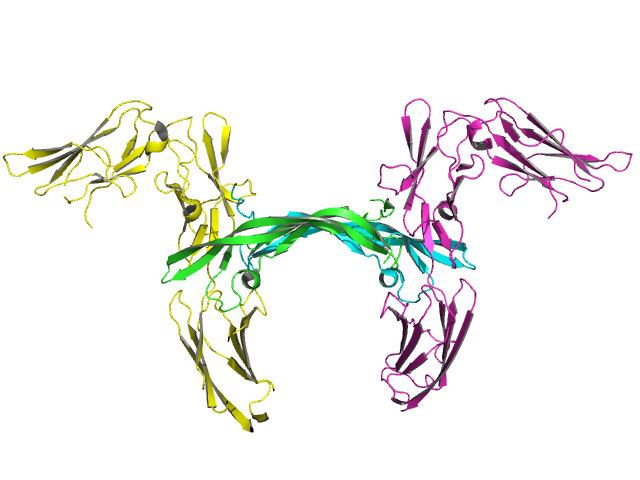Species Human Entrez 5159 | Human Mouse Ensembl ENSG00000113721 | |
 | ||
Aliases PDGFRB, CD140B, IBGC4, IMF1, JTK12, PDGFR, PDGFR-1, PDGFR1, KOGS, PENTT, platelet derived growth factor receptor beta External IDs MGI: 97531 HomoloGene: 1960 GeneCards: PDGFRB | ||
Beta-type platelet-derived growth factor receptor is a protein that in humans is encoded by the PDGFRB gene.
Contents
Structure
The PDGFRB gene encodes a typical receptor tyrosine kinase, which is a transmembrane protein consisting of an extracellular ligand binding domain, a transmembrane domain and an intracellular tyrosine kinase domain. The molecular mass of the mature, glycosylated PDGFRβ protein is approximately 180 kDA.
Modes of activation
Activation of PDGFRβ requires de-repression of the receptor's kinase activity. The ligand for PDGFRβ (PDGF) accomplishes this in the course of assembling a PDGFRβ dimer. Two of the five PDGF isoforms activate PDGFRβ (PDGF-B and PDGF-D). The activated receptor phosphorylates itself and other proteins, and thereby engages intracellular signaling pathways that trigger cellular responses such as migration and proliferation. There are also PDGF-independent modes of de-repressing the PDGFRβ's kinase activity and hence activating it. For instance, forcing PDGFRβ into close proximity of each other by overexpression or with antibodies directed against the extracellular domain. Alternatively, mutations in the kinase domain that stabilize a kinase active conformation result in constitutive activation.
Unlike PDGFRα, PDGFRβ cannot be indirectly activated. This is because PDGFRβ recruits RasGAP and thereby attenuates Ras/PI3K activity, which is required to engage a feed-forward loop that is responsible for this mode of activation.
Role in physiology/pathology
The phenotype of knock out mice demonstrates that pdgfrb is essential for vascular development, and that pdgfb is responsible for activating PDGFRβ during embryogenesis. Eliminating either PDGFRB, or PDGF-B reduces the number of pericytes and vascular smooth muscle cells, and thereby compromises the integrity and/or functionality of the vasculature in multiple organs, including the brain, heart, kidney, skin and eye.
In vitro studies using cultured cells indicate that endothelial cells secrete PDGF, which recruits PDGFRβ-expressing pericytes that stabilize nascent blood vessels. Mice harboring a single activated allele of pdgfrb show a number of postnatal phenotypes including reduced differentiation of aortic vascular smooth muscle cells and brain pericytes. Similarly, differentiation of adipose from pericytes and mesenchymal cells is suppressed. Misregulation of the PDGFRβ's kinase activity (typically activation) contributes to endemic diseases such as cancer and cardiovascular disease.
This gene is flanked on chromosome 5 by the genes for granulocyte-macrophage colony-stimulating factor and macrophage-colony stimulating factor receptor; all three genes may be implicated in the 5q- syndrome. A translocation between chromosomes 5 and 12, that fuses this gene to that of the translocation, ETV6, leukemia gene, results in chronic myeloproliferative disorder with eosinophilia.
Interactions
PDGFRB has been shown to interact with:
